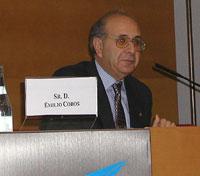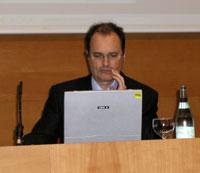Nanostructured materials and materials science
2002/11/21 Andonegi Beristain, Garazi - Elhuyar Zientziaren Komunikazioa

Today we also attended talks on materials. The first conference was given by D. Vicente Sánchez Gálvez, Vice-rector of the Public University of Madrid. The second has been taught by Javier Gil Sevillano, professor of the School of Engineering TECNUM.
Materials and Man
D. Vicente Sánchez, faithfully responding to the objectives of the Science Week, has offered a pleasant, interesting and informative talk. He explained to the attendees how the interaction between materials and human beings has been throughout history, what is the science and engineering of materials, what has meant for the human being this field and what is the future of this science. this century.
Mr. Vicente Sánchez has stated that the materials have had a great importance in the evolution of the human being, and proof of this are the names of the different historical epochs, the Bronze Age, the Iron Age, etc.
Material science, although it may seem old, XX. It is a knowledge of the 20th century. Until then they did not apply the scientific method in the material sessions. Since then, man has been able to design new materials knowing the structure and behaviors of the materials. This scientific knowledge has been applied for the first time in the design of materials needed for specific applications.

The new framework has evolved spectacularly in the 20th century. In the 20th century, Sánchez has presented several examples in his speech. Among them are polymers, superconductors, superalloys, optical fibers, fusion reactors, implant materials, new ceramic materials and composites. In relation to all of them, he mentioned several examples and explained his applications in their respective areas.
Mr. Sanchez has been cautious in predicting future advances in this section of science, as it is not known what will happen. However, he hopes that many things will be achieved. Among them, superconducting materials at room temperature, materials that will
withstand higher temperatures, such as suborbital aircraft, more resistant fibers, in this case with the spider net, and advances in material recycling. Sánchez himself, a supporter of increasingly smaller manufacturing and greater reuse and recycling, has encouraged current young people to work in this field.
When size matters
The second conference was given by TECNUM professor Javier Gil. Mr. Gil has offered a technical paper on nanostructured materials. Going back through history, Leonardo Da Vinci and Galileo have highlighted some of the discoveries made, and explained two bases of nanostructured materials: the hardness of the materials depends on their size and the fragility of their size.

But what are nanostructured materials? They are solids of nanometric internal structure, that is, when the smallest grain of the material is of several nanometers, it is called nanostructured material. We knew and used all these materials, but so far we didn't know they were nanostructured.
He then focused on the characteristics of these materials, explaining their internal structure. In this structure is the capacity of nanostructured materials. The internal structures of the materials are very stable and are also very good for mixing with other materials. This makes them more resistant, the characteristics of metals and ceramics can be combined and, perhaps, superplasticity can be achieved.
What Gil has pointed out is that they have difficulties,
since the analysis of new manufacturing processes and materials requires very complex tools. All this to give better answers to multiple applications, for example, to obtain harder and more resistant tools, new ceramic, biomedical, magnetic materials, hydrogen storage materials, etc.
Finally, taking into account what was said by a scientist, he said that nanostructured materials, created by man, correspond to those produced by nature.

Gai honi buruzko eduki gehiago
Elhuyarrek garatutako teknologia






